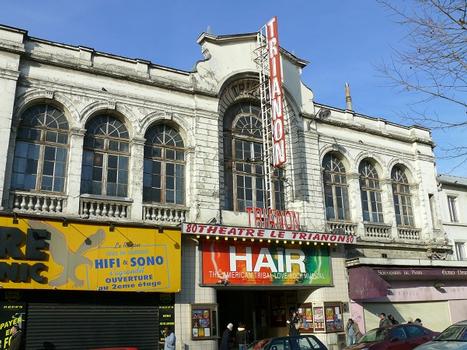General Information
| Other name(s): | Théâtre Victor Hugo; Trianon-Lyrique |
|---|---|
| Completion: | 1902 |
| Status: | in use |
Project Type
| Function / usage: |
Theater building |
|---|
Location
| Location: |
Paris (18th), Paris, Ile-de-France, France |
|---|---|
| Address: | 80 boulevard de Rochechouart |
| Coordinates: | 48° 52' 58.57" N 2° 20' 35.93" E |
Technical Information
There currently is no technical data available.
Excerpt from Wikipedia
Le Trianon is a theatre and concert hall in Paris. It is located at 80, boulevard de Rochechouart, in the 18th arrondissement of Paris, at the foot of the hill of Montmartre.
Café concert (1894–1900)
The Trianon-Concert was built as a café concert in 1894 in the garden of the Élysée Montmartre, which was requisitioned for the purpose. Édouard Jean Niermans (1859–1928), a young architect who designed or rebuilt several theaters around that time, designed and decorated the Trianon-Concert. Opening in 1895, the Trianon-Concert was one of Paris's first music halls. Mistinguett, (Jeanne-Marie Bourgeois) made her debut at the Petit-Casino and the Trianon-Concert in its first year. Although her voice was thin, she was an accomplished mimic and comedian, became known for her shapely legs and risqué routines, and later became a star at the Moulin Rouge.
In 1897 a new owner of the Élysée Montmartre refurbished the property, making two rooms: one for concerts, reviews and recitals, and the other for dancing and skating. The architect, again Édouard Niermans, used steelwork salvaged from Gustave Eiffel's Pavillon de France, built for the Exposition universelle (1889). Artists such as La Goulue, Grille d’Egoût and Valentin le désossé performed on the stage, and Henri de Toulouse-Lautrec was a regular visitor. The quick-change artist Leopoldo Fregoli performed there.
However, on the night of February 17–18, 1900 the hall and some of the other buildings of the Élysée were destroyed by a fire. Only the facade remained. Fregoli, who had been playing there for the past five days, lost all his decorations and costumes.
Theater and music hall (1902–1939)
After the fire, the architect Joseph Cassian Bernard, a student of Charles Garnier and the designer of the Pont Alexandre III, undertook construction of a new 1000-seat theater in the Italian style, with two levels of balconies. It was inaugurated on December 18, 1902 as the Trianon-Théâtre. The theater was renamed the Théâtre Victor-Hugo in 1903, a subsidized theater that gave performances of classical works. In 1906 the theater became the Trianon-Comique. It was home to a branch of the Opéra-Comique that specialized in operetta. Picasso visited the theater and drew portraits of many of the habitués. In 1917 the theater was renamed the Trianon-Lyrique. It became simply Le Trianon in 1920. In 1936 Le Trianon became a music hall, putting on performances by artists such as Yvette Guilbert, Marie Dubas, Fréhel and Pierre Dac.
Cinema (1939–1992)
In 1939 the hall was converted into the Cinéphone Rochechouart, a cinema, using projectors that had been installed in 1936. Jacques Brel frequented the cinema in the early 1950s, where he wrote some of his texts. In the post-war years the cinema was a popular venue, putting on family shows that might include a documentary and newsreel, live performances, and then a movie in color and cinemascope. Costume dramas were followed by swashbuckling adventure films, spaghetti westerns and then karate and kung fu films. However, by the mid-1980s audiences were slumping as TV and VCR provided convenient alternatives to the cinema. In 1992 the cinema was forced to close.
Text imported from Wikipedia article "Le Trianon (theatre)" and modified on December 16, 2022 according to the CC-BY-SA 4.0 International license.
Participants
- Joseph Marie Cassien-Bernard (architect)
Relevant Web Sites
- About this
data sheet - Structure-ID
20043684 - Published on:
19/02/2009 - Last updated on:
09/12/2022





